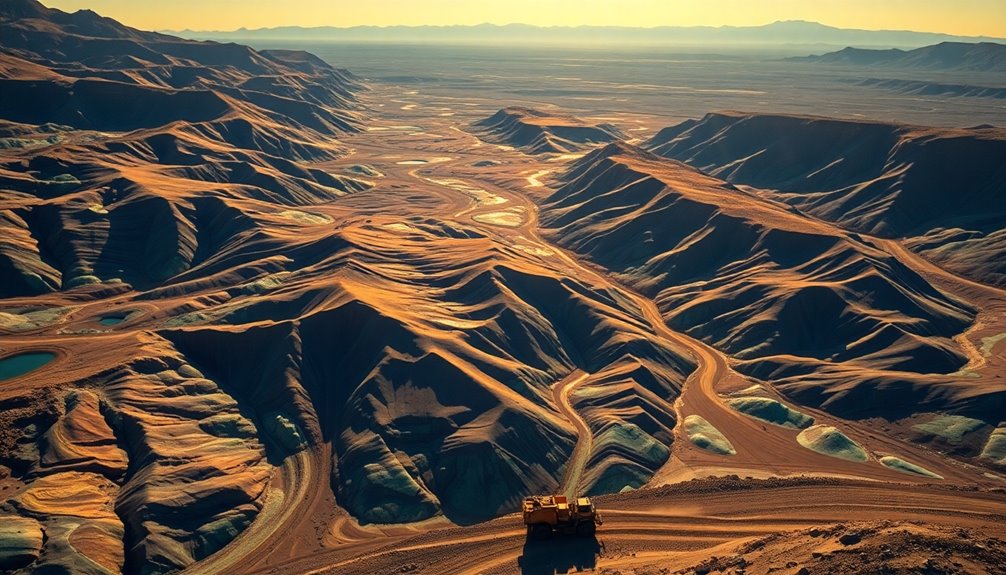If you're looking for the best private placement opportunities in rare earth minerals, consider American Rare Earths and Namibia Critical Metals. American Rare Earths raised around $8.85 million recently to boost growth projects in the U.S. Meanwhile, Namibia Critical Metals operates the promising Lofdal mine. As demand for rare earths skyrockets in high-tech and electric vehicle sectors, investor confidence grows. Companies like MP Materials and Lynas are also solid options, focusing on sustainable practices and innovative technologies. You'll find more about the exciting opportunities and emerging trends that could shape your investment strategy.
Key Takeaways
- American Rare Earths: Recently raised A$13.5 million for projects with significant exploration targets, making it a prime private placement opportunity.
- Northern Minerals: Successfully raised $43 million, positioning itself strongly for future growth in the rare earth sector.
- MP Materials: With revitalized production at Mountain Pass, it offers a solid investment opportunity due to its established market presence.
- Lynas Corporation: As a leading producer, it attracts private placements focusing on enhancing midstream capabilities in the rare earth supply chain.
- Appia Rare Earths: High-grade discoveries at Alces Lake highlight its potential, making it an attractive option for private investors in the sector.
Overview of Rare Earth Minerals
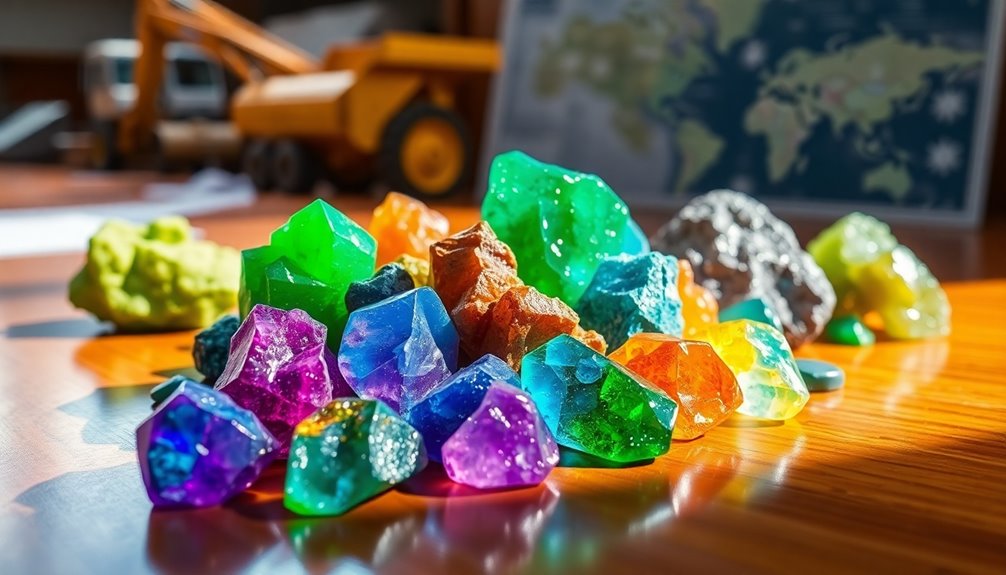
Rare earth minerals, often misunderstood due to their name, play a vital role in modern technology. These minerals primarily contain rare-earth elements, which are part of the lanthanide series, along with scandium and yttrium. While they're called "rare," they're not scarce in the Earth's crust; they're just dispersed and often found in low concentrations. Their silvery-white, soft, and heavy metal composition lends them unique properties that make them essential for various applications.
Geologically, you'll find rare-earth minerals in alkaline and peralkaline igneous complexes, pegmatites, and carbonatite intrusives. They're also associated with hydrothermal deposits. Extraction involves processing large amounts of raw ore, which requires crushing, grinding, and chemical leaching to isolate the rare-earth oxides. Moreover, major sources of rare-earth elements include bastnäsite, monazite, and loparite, which are crucial for understanding the supply chain.
Economically exploitable deposits are limited, with significant resources in countries like China, the United States, and Australia.
These elements are crucial for technologies ranging from permanent magnets and catalytic converters to consumer products like smartphones and LEDs. For instance, neodymium is vital in MRI machines and high-performance magnets.
Understanding their composition and significance can help you appreciate the valuable role rare earth minerals play in our daily lives.
American Rare Earths Profile

American Rare Earths stands out as a key player in the exploration and development of rare earth resources, particularly in the United States.
Based in Australia and New Zealand, the company is listed on the Australian Securities Exchange (ASX) under the code ARR and operates from its head office in Auckland, New Zealand. It focuses on strategic technology mineral resources, with major projects in Arizona and Wyoming.
The Halleck Creek project in Wyoming boasts an exploration target exceeding two billion tonnes of mineralized rare earth rocks, while the La Paz project in Arizona has a JORC resource estimate of 170 million tonnes, with potential to surpass one billion tonnes.
Additionally, the Searchlight Heavy Rare Earths Project near Las Vegas confirms significant Total Rare Earth Oxide (TREO) grades, especially in magnetic rare earths like neodymium and praseodymium. American Rare Earths Limited has active projects primarily located in Arizona, USA, which enhances its prospects in the competitive landscape.
As rare earth elements gain importance in green technologies, including electric vehicles and wind turbines, American Rare Earths is well-positioned to meet the growing demand.
Namibia Critical Metals Insights

As the demand for critical minerals surges, Namibia Critical Metals Inc. emerges as a significant player in the rare earth sector, particularly with its flagship Lofdal mine in the Kunene region. This Canadian company operates in Namibia, focusing on producing essential rare earth elements, including dysprosium and terbium oxides, vital for applications like electric vehicle permanent magnets and wind turbines. The Lofdal mine is projected to produce about 2,000 tonnes of mixed rare earth oxides annually over its 16-year operational life. With substantial reserves outlined in the Lofdal 2B-4 project, the mine aims to enhance Namibia's GDP while creating jobs and fostering skill development. Furthermore, the country's mining sector recorded strong growth of 21.6% in 2022, indicating a vibrant market for rare earth minerals.
However, challenges like inadequate infrastructure, regulatory restrictions on exporting unprocessed minerals, and skill shortages pose hurdles. To address these, Namibia Critical Metals plans to collaborate with partners like Japan Oil, Gas and Metals National Corporation and establish a rare earth separation plant through the Rare Earth Alliance Namibia. This strategic move not only aims to boost local beneficiation and reduce raw material exports but also attracts investment, making it an exciting prospect in the rare earth market.
Funding Strategies and Placements

In the competitive landscape of rare earth minerals, securing adequate funding is crucial for advancing projects like the Halleck Creek Rare Earths Project in Wyoming. Recently, American Rare Earths successfully raised A$13.5 million through a placement, translating to approximately $8.85 million in USD.
With 45 million new shares issued at a placement price of A$0.30—representing a 5.1% discount to the 10-day VWAP—the support from both existing and new institutional investors is noteworthy.
Canaccord Genuity acted as the sole lead manager and bookrunner, with Bell Potter serving as co-lead manager. The funds will primarily drive project development, including mineral resource drilling, pre-feasibility studies, and environmental permitting activities. This funding will also support processing development efforts that are crucial for the project's success.
This strategic allocation underscores the company's commitment to environmentally friendly extraction methods while ensuring alignment with the growing demand for critical minerals.
Moreover, the overwhelming investor confidence highlights the belief in the project's potential and the company's vision. By advancing these funding strategies, you're positioning yourself to capitalize on future opportunities in the critical minerals sector, enhancing both shareholder value and national security objectives.
Project Development Potential
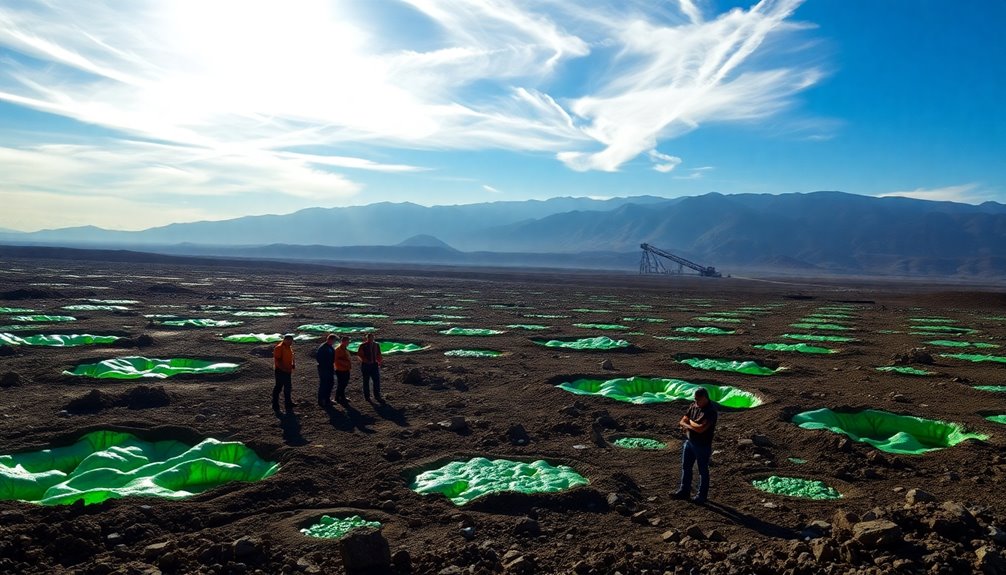
With the demand for rare earth minerals surging, project development potential is becoming increasingly vital. Companies like MP Materials are leading the charge with their Mountain Pass Mine, which has revitalized production and is building the first US rare earth refinement facility. This facility is set to produce 1,000 tons of neodymium-iron-boron magnets annually and will support a full magnetic supply chain, including recycling. Notably, over 85% of rare earth processing capacity is currently located in China, underscoring the importance of domestic production efforts. American Rare Earths is also making strides, with projects in Halleck Creek and La Paz that could house North America's largest rare earth deposits. Their significant mineralized targets position them as key players in the sector. Appia Rare Earths & Uranium Corp. is uncovering high-grade REE at their Alces Lake project, showcasing efficient exploration techniques. Meanwhile, Australian companies like Lynas and Arafura Resources are developing processing facilities that enhance midstream capabilities, further solidifying their roles in the global market. These projects highlight the immense potential in rare earth minerals.
Market Demand and Trends
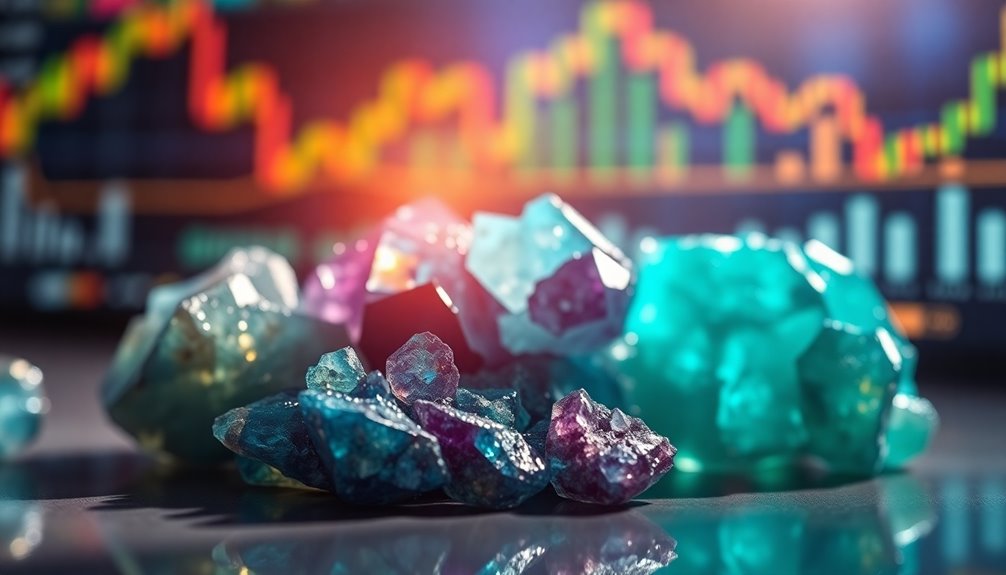
The surging demand for rare earth minerals is reshaping the market landscape, driven by advancements in technology and increasing reliance on sustainable energy solutions.
You'll find that the rare earth metals market is projected to grow significantly, expanding from USD 6.2 billion in 2024 to USD 16.1 billion by 2034, at a CAGR of 10.1%. In particular, the electric vehicle (EV) sector is a major demand driver, as these vehicles depend on rare earth elements for essential components like batteries and motors. Additionally, the increase in government policies promoting clean energy transitions and carbon emission reductions is further fueling this growth.
Moreover, the push for renewable energy technologies, including wind and solar, is boosting the need for these vital minerals. The electronics industry also plays a crucial role, with consumer devices like smartphones and laptops requiring rare earth magnets.
Regionally, Asia-Pacific, especially China, dominates the market, influencing global prices and supply dynamics. However, the U.S. is ramping up its domestic capabilities in response to growing local demand and geopolitical concerns.
Innovations in extraction, recycling processes, and sustainable mining practices are essential trends shaping the future of this industry, ensuring it meets both market needs and environmental responsibilities.
Investor Confidence and Support
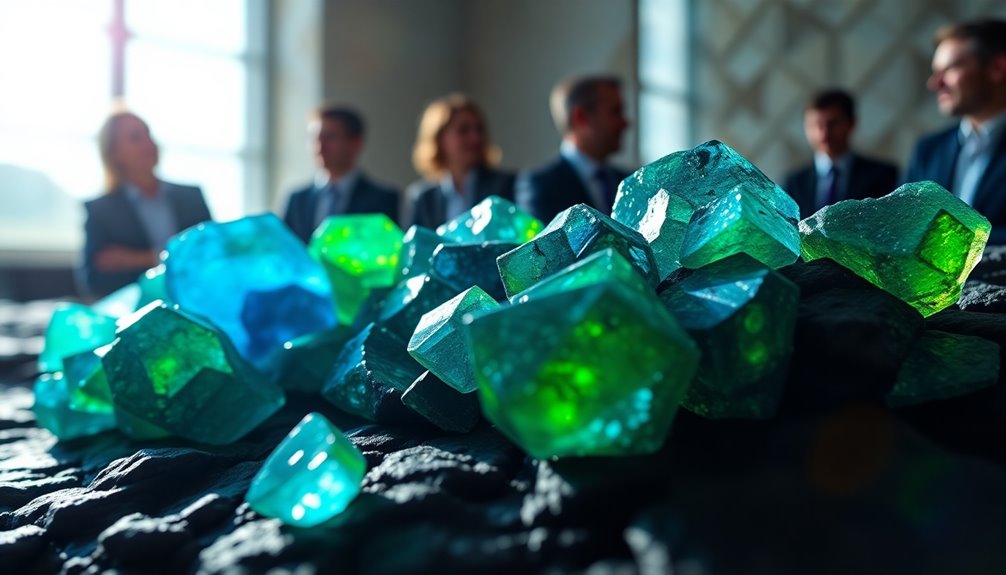
Investor confidence in the rare earth minerals sector is on the rise, fueled by robust project fundamentals and strategic financial commitments. Companies like Northern Minerals and American Rare Earths have attracted substantial investments, raising $43 million and $13.5 million respectively through private placements. This strong backing signals a positive outlook for these projects.
Projects such as Northern Minerals' Browns Range and Namibia Critical Metals' Lofdal Project are particularly appealing due to their advanced stages and significant resource potential. These high-quality assets play a crucial role in attracting investor interest. Additionally, the compliance with regulatory frameworks, as seen with NioCorp and Appia Rare Earths, enhances the sector's credibility and investor trust. The successful capital raising for Browns Range Project demonstrates the strong demand for rare earths investments.
The financial stability demonstrated by these companies, with Northern Minerals raising a total of $48 million, reassures you of their commitment to development.
As you evaluate investment opportunities, consider the strong institutional support and the structured investment processes that many of these companies employ. This growing investor confidence signals a promising future for the rare earth minerals sector, making it a compelling area for your investment consideration.
Frequently Asked Questions
What Are the Environmental Impacts of Rare Earth Mineral Extraction?
When you consider rare earth mineral extraction, you're looking at significant environmental impacts.
Mining releases heavy metals and pollutants, contaminating water and soil. You might notice deforestation and biodiversity loss due to open pits and leaching ponds.
The production process generates massive waste, including radioactive materials, posing health risks. Communities near mining sites often face higher illness rates, making it crucial to explore sustainable alternatives and stricter regulations to mitigate these harms.
How Do Rare Earth Minerals Affect Technological Advancements?
Rare earth minerals significantly enhance technological advancements.
They're essential for creating high-performance electronics like smartphones and electric vehicles, driving innovation in clean energy technologies such as wind turbines and solar panels.
By enabling more efficient motors and high-capacity batteries, these elements push the boundaries of what's possible in tech.
As you embrace these advancements, you'll notice how vital rare earths are for a sustainable and connected future.
What Are the Risks Associated With Investing in Rare Earth Projects?
When you invest in rare earth projects, you face several risks.
Price volatility can severely affect your returns, as market swings often arise from supply-demand imbalances.
Geopolitical tensions, especially with China, can disrupt supply chains, impacting your investments.
Additionally, operational challenges in mining and processing rare earths require significant expertise and capital.
Lastly, environmental regulations may complicate project development, potentially increasing costs and timelines, making it crucial to assess these factors carefully.
How Is the Global Supply Chain for Rare Earths Structured?
The global supply chain for rare earths is complex and interconnected.
You'll find that it involves multiple stages, from mining to processing and eventual distribution.
China dominates the market, controlling a significant share of production and processing.
However, countries like the U.S., Australia, and Canada are working to diversify sources and build domestic supply chains.
Geopolitical tensions and market fluctuations can disrupt this intricate network, impacting industries that rely on these essential materials.
What Role Does Government Policy Play in Rare Earth Exploration?
Government policy plays a crucial role in rare earth exploration. It shapes funding opportunities, streamlines regulations, and promotes environmental standards.
You'll notice that initiatives like the Bipartisan Infrastructure Law provide significant financial support for projects, enhancing domestic production.
Plus, updated mining regulations make it easier for you to access resources. By focusing on community engagement and national security, these policies create a more sustainable and equitable landscape for rare earth exploration.
Conclusion
In conclusion, diving into private placement opportunities in rare earth minerals can be a smart move for savvy investors. With companies like American Rare Earths and Namibia Critical Metals leading the charge, there's significant potential for growth. Understanding funding strategies and market trends will empower you to make informed decisions. As demand for these essential materials continues to rise, your confidence in these investments could lead to rewarding returns. Don't miss out on this exciting sector!

